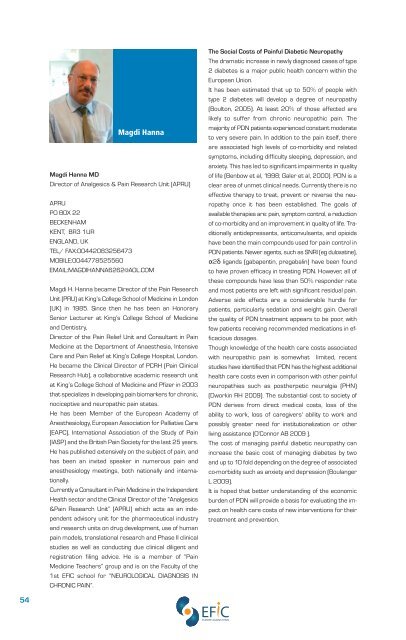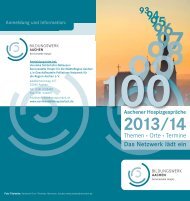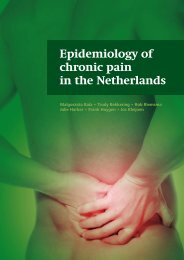First EFIC® Symposium Societal Impact of Pain - SIP
First EFIC® Symposium Societal Impact of Pain - SIP
First EFIC® Symposium Societal Impact of Pain - SIP
Create successful ePaper yourself
Turn your PDF publications into a flip-book with our unique Google optimized e-Paper software.
54<br />
Magdi Hanna<br />
Magdi Hanna MD<br />
Director <strong>of</strong> Analgesics & <strong>Pain</strong> Research Unit (APRU)<br />
APRU<br />
PO BOX 22<br />
BECKENHAM<br />
KENT, BR3 1UR<br />
ENGLAND, UK<br />
TEL/ FAX:00442083256473<br />
MOBILE:0044778525560<br />
EMAIL:MAGDIHANNA6262@AOL.COM<br />
Magdi H. Hanna became Director <strong>of</strong> the <strong>Pain</strong> Research<br />
Unit (PRU) at King’s College School <strong>of</strong> Medicine in London<br />
(UK) in 1985. Since then he has been an Honorary<br />
Senior Lecturer at King’s College School <strong>of</strong> Medicine<br />
and Dentistry,<br />
Director <strong>of</strong> the <strong>Pain</strong> Relief Unit and Consultant in <strong>Pain</strong><br />
Medicine at the Department <strong>of</strong> Anaesthesia, Intensive<br />
Care and <strong>Pain</strong> Relief at King’s College Hospital, London.<br />
He became the Clinical Director <strong>of</strong> PCRH (<strong>Pain</strong> Clinical<br />
Research Hub), a collaborative academic research unit<br />
at King’s College School <strong>of</strong> Medicine and Pfizer in 2003<br />
that specializes in developing pain biomarkers for chronic,<br />
nociceptive and neuropathic pain states.<br />
He has been Member <strong>of</strong> the European Academy <strong>of</strong><br />
Anesthesiology, European Association for Palliative Care<br />
(EAPC), International Association <strong>of</strong> the Study <strong>of</strong> <strong>Pain</strong><br />
(IASP) and the British <strong>Pain</strong> Society for the last 25 years.<br />
He has published extensively on the subject <strong>of</strong> pain, and<br />
has been an invited speaker in numerous pain and<br />
anesthesiology meetings, both nationally and internationally.<br />
Currently a Consultant in <strong>Pain</strong> Medicine in the Independent<br />
Health sector and the Clinical Director <strong>of</strong> the “Analgesics<br />
&<strong>Pain</strong> Research Unit” (APRU) which acts as an independent<br />
advisory unit for the pharmaceutical industry<br />
and research units on drug development, use <strong>of</strong> human<br />
pain models, translational research and Phase II clinical<br />
studies as well as conducting due clinical diligent and<br />
registration filing advice. He is a member <strong>of</strong> “<strong>Pain</strong><br />
Medicine Teachers” group and is on the Faculty <strong>of</strong> the<br />
1st EFIC school for “NEUROLOGICAL DIAGNOSIS IN<br />
CHRONIC PAIN”.<br />
The Social Costs <strong>of</strong> <strong>Pain</strong>ful Diabetic Neuropathy<br />
The dramatic increase in newly diagnosed cases <strong>of</strong> type<br />
2 diabetes is a major public health concern within the<br />
European Union.<br />
It has been estimated that up to 50% <strong>of</strong> people with<br />
type 2 diabetes will develop a degree <strong>of</strong> neuropathy<br />
(Boulton, 2005). At least 20% <strong>of</strong> those affected are<br />
likely to suffer from chronic neuropathic pain. The<br />
majority <strong>of</strong> PDN patients experienced constant moderate<br />
to very severe pain. In addition to the pain itself, there<br />
are associated high levels <strong>of</strong> co-morbidity and related<br />
symptoms, including difficulty sleeping, depression, and<br />
anxiety. This has led to significant impairments in quality<br />
<strong>of</strong> life (Benbow et al, 1998; Galer et al, 2000). PDN is a<br />
clear area <strong>of</strong> unmet clinical needs. Currently there is no<br />
effective therapy to treat, prevent or reverse the neuropathy<br />
once it has been established. The goals <strong>of</strong><br />
available therapies are: pain, symptom control, a reduction<br />
<strong>of</strong> co-morbidity and an improvement in quality <strong>of</strong> life. Traditionally<br />
antidepressants, anticonvulsants, and opioids<br />
have been the main compounds used for pain control in<br />
PDN patients. Newer agents, such as SNRI (eg duloxatine),<br />
α2δ ligands (gabapentin, pregabalin) have been found<br />
to have proven efficacy in treating PDN. However, all <strong>of</strong><br />
these compounds have less than 50% responder rate<br />
and most patients are left with significant residual pain.<br />
Adverse side effects are a considerable hurdle for<br />
patients, particularly sedation and weight gain. Overall<br />
the quality <strong>of</strong> PDN treatment appears to be poor, with<br />
few patients receiving recommended medications in efficacious<br />
dosages.<br />
Though knowledge <strong>of</strong> the health care costs associated<br />
with neuropathic pain is somewhat limited, recent<br />
studies have identified that PDN has the highest additional<br />
health care costs even in comparison with other painful<br />
neuropathies such as postherpetic neuralgia (PHN)<br />
(Dworkin RH 2009). The substantial cost to society <strong>of</strong><br />
PDN derives from direct medical costs, loss <strong>of</strong> the<br />
ability to work, loss <strong>of</strong> caregivers' ability to work and<br />
possibly greater need for institutionalization or other<br />
living assistance (O’Connor AB 2009 ).<br />
The cost <strong>of</strong> managing painful diabetic neuropathy can<br />
increase the basic cost <strong>of</strong> managing diabetes by two<br />
and up to 10 fold depending on the degree <strong>of</strong> associated<br />
co-morbidity such as anxiety and depression (Boulanger<br />
L 2009).<br />
It is hoped that better understanding <strong>of</strong> the economic<br />
burden <strong>of</strong> PDN will provide a basis for evaluating the impact<br />
on health care costs <strong>of</strong> new interventions for their<br />
treatment and prevention.






